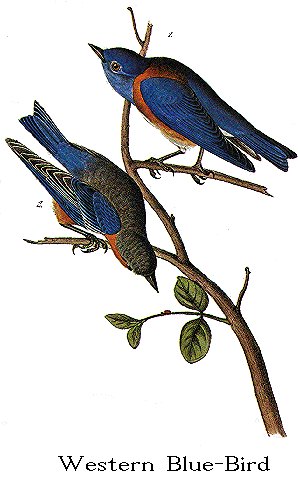
| Family XI. SYLVIANAE. WARBLERS. GENUS II. SIALIA, Swains. BLUE-BIRD. |
Next >> |

Family |
WESTERN BLUE-BIRD. [Western Bluebird.] |
| Genus | SIALIA OCCIDENTALIS, Towns. [Sialia mexicana.] |
Of this handsome bird, which was discovered by Mr. TOWNSEND, Mr. NUTTALL
has favoured me with the following notice:--"The Western Blue-bird possesses
many of the habits of our common kind. The male is equally tuneful throughout
the breeding season. Mounting some projecting branch of an oak or low pine, he
delivers his delightful ditty with great energy, extending his wings, and
exerting all his powers as it were to amuse his sitting mate, or to allure
attention to his short, often-repeated, but thrilling lay. In the midst of all
this charming employment economy is rarely forgotten, and a crawling beetle or
busy insect is no sooner seen than snatched up by our still watchful songster,
who resumes his wonted perch, to be again interrupted by the cares of providing
a subsistence; or, reiterating his melody, strives to drown the song of some
neighbouring rival by tender strains and more earnest endeavours. He appears
also equally solicitous with our common species to shew his affection for his
mate, whom he constantly accompanies, feeds, and caresses with an ardour of
affection seldom rivalled. His song is more varied, sweet and tender than that
of the common Sialia, and very different in many of its expressions. In the
small rocky prairies of the Columbia, near its bank, where I first heard and saw
this species, they were exceedingly shy, probably in consequence of the presence
of birds of prey, which prowled around, and it was with difficulty that we got
sight of them, but afterwards, in the vicinity of Santa Barbara, in Upper
California, I saw them in considerable numbers, and very familiar, making at
this time (April) their nests in the knot-holes of the oaks which abound in the
neighbouring plains. We first met a flock of young birds alone, in the winter,
near to Fort Vancouver, flitting through the tall fir trees, like so many
timorous and silent winter passengers. These had so much the appearance of
young of the common species, that for some time we paid little attention to
them; but their silence, the absence of the usual complaints of t shaye vit,
&c., and at length their different notes, convinced me of their being distinct,
previous to any examination of their plumage. This species, unlike Sialia
arctica, does not extend to the mountains, but seems constantly to affect
similar situations with our common kind, along the coast of the Pacific, as
ours does along that of the Atlantic."
I have given figures of both the male and the female in their spring dress.
SIALIA OCCIDENTALIS, Western Blue-bird, Towns., Journ. Acad. Nat. Sc.
Philadelphia, vol. vii. p. 188.
WESTERN BLUE-BIRD, Sylvia occidentalis, Aud. Orn. Biog., vol. v. p. 41.
Adult Male in summer.
This species in size and form, as well as in colour, is very similar to the
Common Blue-bird. Its bill is of ordinary length, nearly straight, broader than
high at the base, compressed toward the end; upper mandible with the dorsal line
straight and a little declinate at the base, convex toward the end, the ridge
narrow, the sides convex toward the end, the edges direct and overlapping, with
a slight notch close to the narrow deflected tip; lower mandible with the angle
of moderate length and narrow, the dorsal line straight, the sides convex, the
edges direct, the tip narrow. Nostrils basal, elliptical, operculate, partially
concealed by the feathers.
Head rather large; neck short; body moderately full. Feet of ordinary
length, slender; tarsus compressed, covered anteriorly with seven scutella,
behind with two long plates meeting so as to form a thin edge; toes of moderate
length; the first stouter, the second and fourth nearly equal, the third much
longer; claws moderate, well curved, compressed, laterally grooved, tapering to
a fine point.
Plumage soft and blended, with considerable gloss. Short bristles at the
base of the upper mandible. Wings very long; the first quill very small, being
only seven-twelfths of an inch long, the second half a twelfth shorter than the
third, which is longest, but only exceeds the fourth by three-fourths of a
twelfth; the other primaries rapidly graduated; outer secondaries emarginate,
inner not elongated. Tail rather long, deeply emarginate, the middle feathers
being four-twelfths of an inch shorter than the longest.
Bill and feet black; iris brown. The general colour of the upper parts is
bright blue, of a tint approaching to ultramarine; a broad band across the fore
part of the back, and the scapulars, chestnut-red; the quills and larger coverts
dark greyish-brown, the outer webs blue, the primaries light brown at the end,
the secondaries faintly margined with whitish. The tail-feathers are also brown
toward the end, but blue toward the base; the lateral with the margin of the
outer web whitish. The sides and fore part of the neck are light blue, tinged
with grey; the fore part of the breast and the sides of the body light
chestnut-red; the rest of the lower parts greyish-white, tinged with blue.
Length to end of tail 7 inches; bill along the ridge (5 3/4)/12, along
the edge of lower mandible (7 1/2)/12; wing from flexure 4 5/12; tail 2 10/12;
tarsus 10/12, hind toe 4/12, its claw 4/12; middle toe 8/12, its claw 3/12.
Adult Female in summer.
The female differs from the male in the same degree as that of the Arctic
Blue-bird from its male; the upper parts being light greyish-brown, tinged with
blue, which is brighter on the rump; the wings and tail are as in the male, but
with less blue; the lower parts are bluish-grey, the breast and sides light
brownish-red, tinged with grey.
| Next >> |